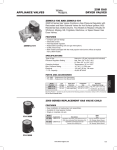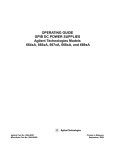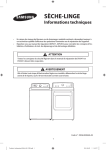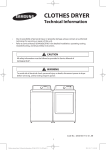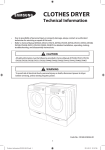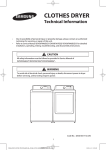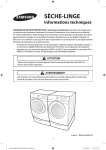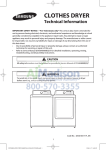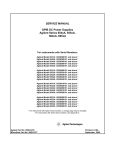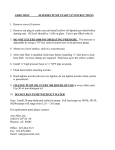Download White Rodgers 25M01A-100 Installation Instructions
Transcript
25M01A-100 to 25M01A-199 HSI Single Stage Combination Gas Valve INSTALLATION INSTRUCTIONS Operator: Save these instructions for future use! FAILURE TO READ AND FOLLOW ALL INSTRUCTIONS CAREFULLY BEFORE INSTALLING OR OPERATING THIS CONTROL COULD CAUSE PERSONAL INJURY AND/OR PROPERTY DAMAGE. DESCRIPTION The 25M01A series valve is a combination gas pressure regulator and dual automatic gas valve. These valves are designed for gas clothes dryers with Hot Surface Ignition (HSI) systems. These valves are equipped with redundant and main solenoid valves that control the gas flow to the burner, and a direct acting pressure regulator. SPECIFICATIONS Type of Gas: Mounting Positions: Control may be mounted in the following positions: horizontal, vertical or 90° of horizontal. NOT UPSIDE DOWN. Natural gas LP gas (use conversion kit) Pressure Regulator Setting: Nat. Gas – 2.5" to 5.4" W.C. LP Gas – 7.0 to 12.0"W.C. PIPE SIZES/CAPACITIES Ambient Temperature: 32° to 155°F Pressure Rating: Pipe Sizes Available (inches) 14" W.C. (1/2 PSI) max. Voltage: 120 VAC Frequency: 60 Hz Current: .06 amps 3/8" NPT Inlet Capacity (BTU/hr) at 1” pressure drop across valve AGA Std. Nat. Gas LP Gas (1,000 BTU/cu. ft.) (2,500 BTU/cu. ft.) 40,000 65,000 CONTENTS Description ......................................................... Specifications ..................................................... Precautions ........................................................ Installation .......................................................... Adjustment ......................................................... Pressure Regulator Adjustment Lighting Instructions............................................ 1 1 2 2 3 4 PART NO. 37-6643B www.white-rodgers.com www.emersonclimate.com Replaces 37-6643A 1207 PRECAUTIONS DO NOT BEGIN INSTALLATION UNTIL YOU READ THE FOLLOWING PRECAUTIONS. ! WARNING If you do not follow these instructions exactly, a fire or explosion may result, causing property damage, personal injury or loss of life. 3. NEVER USE FLAME OR ANY KIND OF SPARK TO CHECK FOR GAS LEAKS–COULD CAUSE FIRE AND/OR EXPLOSION. 1. Failure to turn off electric or main gas supply to clothes dryer could cause personal injury and/or property damage by shock, gas suffocation, fire, and/or explosion. 4. Do not use a control set for natural gas with LP gas, or a control set for LP gas with natural gas. Personal injury and/or property damage, gas suffocation, fire, and/or explosion may result. 2. Do not use this control on circuits exceeding specified voltage. Higher voltage will damage the control and may cause shock or fire hazard. ! CAUTION 2. This control is not intended for use in locations where it may come in direct contact with water. Suitable protection must be provided to shield the control from exposure to water (dripping, spraying, rain, etc.). 1. Do not short out terminals on gas valve or primary control to test. Short or incorrect wiring can cause equipment damage, property damage, and/or personal injury. INSTALLATION 1. Before attempting to service dryer, unplug power cord, turn off main gas supply and consult dryer manufacturer's instructions for accessing gas valve. 2. Disconnect exhaust vent duct. 3. Disconnect gas line from rear of dryer. 4. Remove access panel from dryer. On some models this involves removing the entire front panel. 5. The gas valve/burner assembly should now be visible. 6. The burner assembly consists of (see figure 1 & 2): a. Gas inlet pipe. b. Brass inlet fitting with union – some models may also have a manual shut-off valve. c. Gas valve. d. Mounting bracket. e. Burner orifice. f. Burner assembly with air shutter. g.Igniter. h. Radiant sensor – located on heat exchanger on some models. 7. Disconnect the wiring harness from gas valve and igniter. 8. Remove screw(s) fastening the mounting bracket to the bottom of dryer. 9. Burner assembly should now be free to slide out of the front of dryer. Take care not to bump or jar igniter. It is very fragile. 10.Remove the gas inlet pipe by unscrewing the union. 11.Remove screw(s) fastening the gas valve to the mounting bracket and set them aside. They will be reused. 12.The gas valve should now be free to slide out of burner and off of mounting bracket. Take care not to disturb the air shutter. G H E (not shown) F G H A B shown) F E (not C C A Figure 1 E B C Figure 2 B D C 2 B D E INSTALLATION (cont.) 19. Slide the outlet boss of the new valve into the burner. Take care not to disturb the air shutter. 20. Fasten the gas valve to the mounting bracket using the screw(s) removed earlier. 21. Connect the gas inlet pipe to the inlet fitting by threading the union together and tightening to 150 lbf-in (12.5 lbf-ft). 22. Insert the burner assembly back into the dryer so that the gas inlet pipe exits through the square hole in the back of the dryer cabinet, and the burner fits inside the heat exchanger. Take care not to bump or jar igniter. It is very fragile. 23. Fasten the mounting bracket to the bottom of the dryer cabinet using the screw removed earlier. 24. Reconnect the wiring harness to the igniter and the gas valve. 25. Reconnect the exhaust vent duct to the back of the dryer. 26. Apply pipe sealant to the threads of the inlet gas pipe and reconnect the gas line to the back of the dryer and tighten. 27. Turn on gas supply and Check for leaks. 28. Remove the outlet pressure tap from the gas valve (see figure 3). Apply pipe sealant to the 1/8-inch NPT threads of a hose barb. Install the hose barb into the outlet pressure tap and tighten to 40 lbf-in (see figure 4). 29. Connect a manometer to the hose barb. Manometer should be capable of measuring pressure from 2.5" WC up to 14.0" WC. 30. If entire front cover was removed, the connector for the door switch must be temporarily jumpered. Otherwise the dryer will not function. Outlet Pressure Tap (Plugged) Figure 3 Hose Barb Installed in Outlet Pressure Tap Figure 4 NOTE: On some dryers, the front cover supports the drum. On these models, the drum must be removed in order to energize the system and adjust the regulator. 31. Plug dryer power cord into electrical socket. 32. Energize dryer and verify ignition. Also observe the reading on the manometer. It should read the same outlet pressure as stated on the rating plate on the old gas valve. If it does not, see section on Pressure Regulator Adjustment. 33. De-energize the dryer. 34. Remove the hose barb. 35. Apply pipe sealant to the 1/8 inch NPT plug screw. Install the 1/8 inch NPT plug screw into the outlet pressure tap and tighten 40 lbf-in. 36. Check for leaks. 37. Remove temporary jumper from door switch connector and reconnect to door switch. 38. Reinstall the access panel/front cover. 13. Remove inlet fitting from old gas valve and set it aside. Take care not to damage the sealing surfaces. This part will be reused. 14. Clean the threads of the inlet fitting. Apply pipe sealant (approved for all gases) to the threads. Install the fitting into the inlet of the new valve and tighten to 200 lbf-in (16.6 lbf-ft) using a 3/8 inch hex head wrench. 15. Remove orifice screw from old gas valve and set it aside. Take care not to damage the sealing surfaces. This part will be reused. 16. Inspect the threads of the orifice screw and clean if necessary. 17. Inspect the orifice hole and remove any foreign material. 18. Install orifice screw into new valve and tighten to 40 lbf in. Do not use any pipe sealant. ADJUSTMENT PRESSURE REGULATOR ADJUSTMENT NOTE This control was shipped from the factory with the regulator set as specified on the control label. Consult the appliance rating plate to ensure burner manifold pressure is as specified. If outlet pressure adjustment is required, follow these steps. If a valve has been factory-adjusted for the 2.5 to 5 inches W.C. range, it cannot be field-adjusted outside that range. This is also true for valves adjusted to the 7.0 to 12 inches W.C. range for LP gas. 3 ADJUSTMENT (cont.) 1. Unplug dryer power cord. 2. Attach a hose and manometer to the hose barb in the tap of the valve (see figure 5). 3. Turn on system power and energize valve. 4. Remove regulator cover screw and turn regulator adjust screw clockwise ( ) to increase pressure, or counterclockwise ( ) to decrease pressure (see figure 6). Always adjust regulator to provide the correct pressure according to the original equipment manufacturer’s specifications listed on the appliance rating plate. 5. Replace regulator cover screw and tighten securely. 6. Turn off all electrical power to the system. 7. Remove manometer hose from outlet pressure hose barb. 8. Remove hose barb and replace plug. Use pipe sealant. 9. Plug in power cord. 10.Using a leak detection solution, check for leaks at pressure boss screw. Bubbles forming indicate a leak. SHUT OFF GAS AND FIX ALL LEAKS IMMEDIATELY. REGULATOR ADJUSTMENT TOWER Figure 5 HOSE BARB INSTALLED REGULATOR COVER SCREW PLASTIC ADJUST SCREW REGULATOR SPRING Figure 6 LIGHTING INSTRUCTIONS ! WARNING If you do not follow these instructions exactly, a fire or explosion may result causing property damage, personal injury or loss of life. A. This appliance does not have a pilot. It is equipped with an ignition device which automatically lights the burner. Do not try to light the burner by hand. • Immediately call your gas supplier from a neighbor’s phone. Follow the gas supplier’s instructions. B. BEFORE OPERATING smell all around the appliance area for gas. Be sure to smell next to the floor because some gas is heavier than air and will settle on the floor. • If you cannot reach your gas supplier, call the fire department. FOR YOUR SAFETY “WHAT TO DO IF YOU SMELL GAS” • Do not try to light any appliance. • Do not touch any electrical switch; do not use any phone in your building. C. Do not use this appliance if any part has been under water. Immediately call a qualified service technician to inspect the appliance and to replace any part of the control system and any gas control which has been under water. 1. Unplug power cord to the appliance. 2. Slide dryer away from wall. 3. Close manual shut-off valve for dryer, if none present, shut off gas supply line where it enters the building. White-Rodgers is a business of Emerson Electric Co. The Emerson logo is a trademark and service mark of Emerson Electric Co. www.white-rodgers.com www.emersonclimate.com





